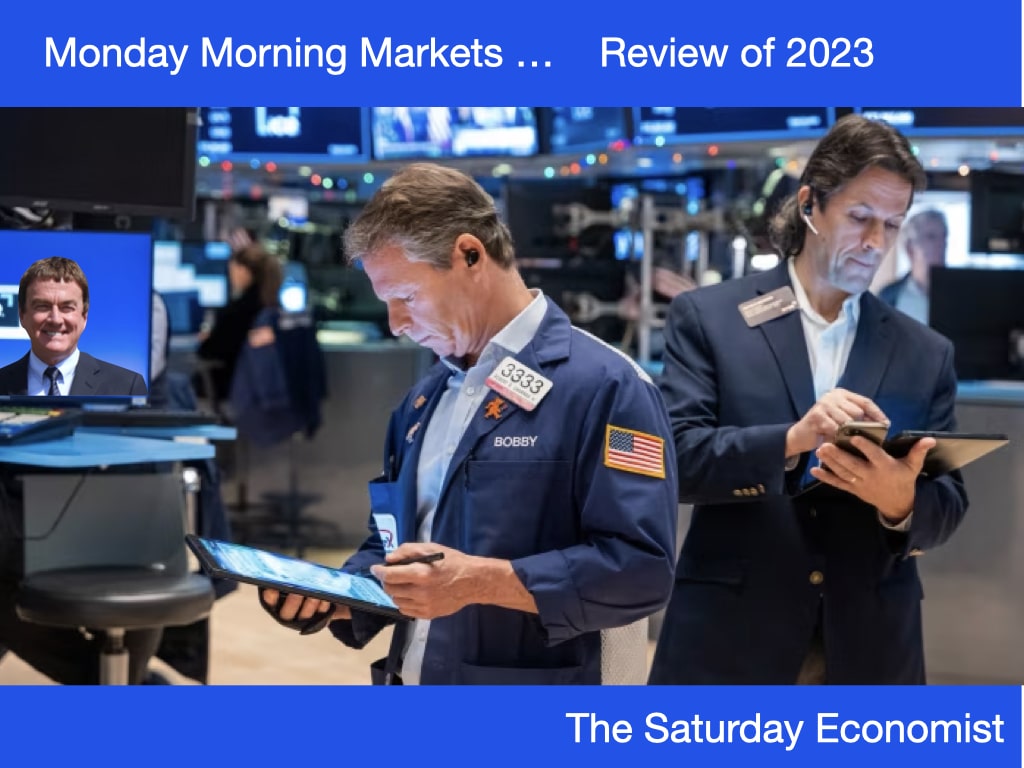|
We track ten markets in our global equities model. The Dow, S&P and NASDAQ in the U.S.A, the FTSE, CAC and Dax in Europe. In Asia, Nikkei, Hang Seng, Shanghai and BSE feature. This is our review of 2023.
Global equity markets experienced their strongest year since 2019, with the MSCI World index, a broad gauge of global developed market equities, surging by 22%. This performance was driven by a strong rally towards the end of the year, as investors anticipated that major central banks had finished raising interest rates and would implement significant rate cuts in 2024. In the United States, the NASDAQ led the way with a 43% increase, followed by the S&P 500 index with a 24% rise, and the Dow Jones Industrial Average with a 14% gain. This growth was largely driven by a shift in interest rate expectations, as recent data showed inflation falling faster than expected in western economies. The Federal Reserve signaled the possibility of substantial rate cuts in 2024, which further fueled this optimism. European stocks also performed well in 2023, with the German DAX and French CAC indices rising by 20% and 16.5% respectively. However, the FTSE lagged behind, closing just above the 7700 level, for a 4% gain in the year. Asian markets had a mixed performance. The Nikkei index in Japan surged by 28%, and the BSE index in India was up by 19%. However, concerns about the investment outlook in China led to a 4% fall in the Shanghai index and a 14% drop in the Hong Kong Hang Seng. A handful of big technology stocks, known as the "Magnificent Seven" (Apple, Microsoft, Alphabet, Amazon, Tesla, Meta, and Nvidia), drove a large part of the gains on Wall Street in the year. Looking ahead to 2024, some investors believe that markets may be pricing in too much optimism that inflation will continue to trend lower without the US economy slipping into recession. Expectations of significant rate cuts in the USA and UK could be overblown, and the 40% gain in NASDAQ stocks may need a period of repricing before further gains are possible. Our premium to value is 5%, with significant stress still evident in Hang Seng and Shanghai. The contrarians would appear to benefit from a move into Hang Seng and Shanghai as Europe and U.S. appear over priced. Nikkei continues to look over played. We would look for a 10% correction in the US and a 5% adjustment in Europe.
0 Comments
Leave a Reply. |
The Saturday EconomistAuthorJohn Ashcroft publishes the Saturday Economist. Join the mailing list for updates on the UK and World Economy. Archives
July 2024
Categories
All
|
| The Saturday Economist |
The material is based upon information which we consider to be reliable but we do not represent that it is accurate or complete and it should not be relied upon as such. We accept no liability for errors, or omissions of opinion or fact. In particular, no reliance should be placed on the comments on trends in financial markets. The presentation should not be construed as the giving of investment advice.
|
The Saturday Economist, weekly updates on the UK economy.
Sign Up Now! Stay Up To Date! | Privacy Policy | Terms and Conditions | |

 RSS Feed
RSS Feed